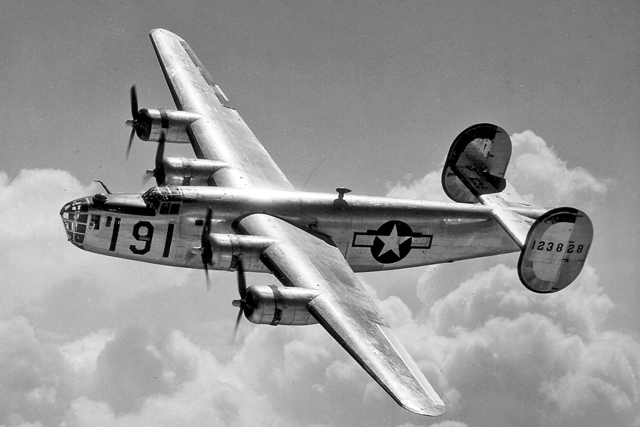
Bringing home the remains of those missing in action is America’s sacred duty, said Army Capt. Jordan Smith.
Smith, the leader of a 25-member team from the Defense POW/MIA Accounting Agency, is working to recover the remains of airmen lost during World War II.
On April 8, 1944, a flight group of about 200 aircraft from the 8th U.S. Air Force were returning from a successful mission targeting a synthetic oil factory in Germany that was critical to Germany’s war effort, as well as two factories that produced Messerschmitt ME-110 fighter aircraft.
The flight group encountered heavy resistance, losing 31 B-24H Liberator bombers.
One of the B-24s was last seen on the return flight, accompanying other bombers in northern Germany where it was presumed shot down with the loss of all crew members.
The flight crew included four officers and six enlisted service members. The officers were first and second lieutenants who served as the pilot, co-pilot, navigator and bombardier. The enlisted service members ranged in rank from sergeant to staff sergeant and served as a radio operator, ball turret gunner, right waist gunner, left waist gunner, tail gunner and top turret gunner.
After the war, the site of the crash fell into Soviet-controlled East Germany after the war, thus complicating access for U.S. graves registration and recovery teams until after Germany’s reunification in 1990.
The site currently being excavated has been a subject of research and investigations involving multiple researchers since at least 2015, according to the agency.
Recent investigations and surveys of the site involved use of wartime aerial photographs, captured German shoot-down records, local cemetery records, and geophysical remote sensing to differentiate aircraft debris from buried gas lines and other infrastructure, as well as eyewitness accounts, according to the agency.
David Brown, a forensic archeologist for the B-24 recovery mission, said the ongoing recovery efforts began on Aug. 1.
Before excavation could begin, German authorities were notified of the planned recovery mission, and their input was noted. Also notified was the local farmer who owns the land, Brown said. A full explanation was given to area residents about how the work would be conducted with as little disturbance to the area as possible.
A one-hectare area was leased from the farmer, who was pleased to assist, Brown said. A security fence was erected around the perimeter to prevent anyone from going into the site and injuring themselves by falling into the excavation pit or being cut by sharp objects.
Since topsoil is very important for farming, all of it was carefully removed and placed into a pile, which eventually will be used to restore the site to its previous state once the work is completed, he said.
The site where most of the bomber crashed was located by a magnetometer, an instrument that measures changes in the Earth’s magnetic field, he said.
So far, the team has excavated a hole about 2 meters deep and about as wide as half a tennis court. Brown said the hole will most likely need to be enlarged down to a total of 5 to7 meters, where the nose of the plane is expected to be found. It will also have to be widened.
Already, some of the plane’s propellers, which are still recognizable, have been recovered. Most of the aircraft, including the propellers, was made from aluminum; much of it has turned to a green and white powder due to environmental corrosion, Brown said. Aluminum manufactured at the time didn’t contain the protective alloys available today.
Brown said care is taken when removing the soil because live ordnance is still in the ground. An explosives ordnance disposal expert is on site to remove it, and German authorities will dispose of it.
After the earth is removed, team members haul it in buckets to a large filtration sorting area, which consists of numerous steel mesh screens and overhead water hoses that are used to remove the soil and clay from potential artifacts. The water then allows the soil to drop through the screens. What’s left on the screen are pebbles and small rocks, which are disposed of according to the farmer’s wishes, Brown said.
Also found on the screens are parts of the plane and pieces the airmen’s equipment: uniforms, parachutes, life vests, coins from the United Kingdom where the airmen were stationed, wrist watches, dog tags, pocketknives, weapons, ammunition and many other items, he said.
The depth of the crater indicates a steep crash angle. Parts of the aircraft were severely distorted with a lot of melting, resulting from the fire that ensued, he said.
All evidence is catalogued, put into numerous plastic zip-close bags with silica gel desiccant packs. The contents of each bag are labeled with a description of the item and the date and location of its discovery. The bags are then placed in locked protective cases and stored away from the sun and other elements to be shipped stateside soon, he said.
U.S. military aircraft at Ramstein Air Base, Germany, will transport the cases, accompanied by chain-of-custody personnel, to Offutt Air Force Base, Nebraska, where one of the agency’s two forensic laboratories are located.
“The team at the site will include all potential osseous material out of an abundance of caution,” Brown said, referring to bone tissue. Forensic experts at the Offutt lab will then conduct further analysis.
The site in Germany is one of many in 45 nations where the agency is searching for missing U.S. service members from past conflicts. There are still over 81,000 personnel missing in action, so the agency’s work will continue into the foreseeable future.


